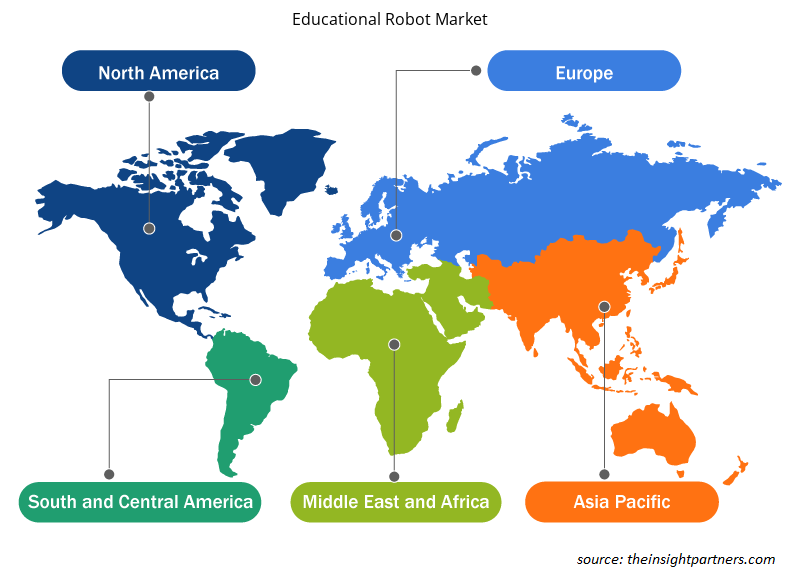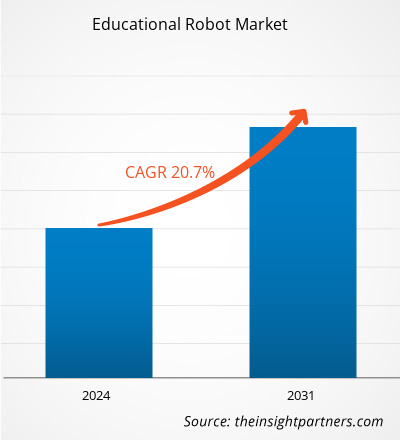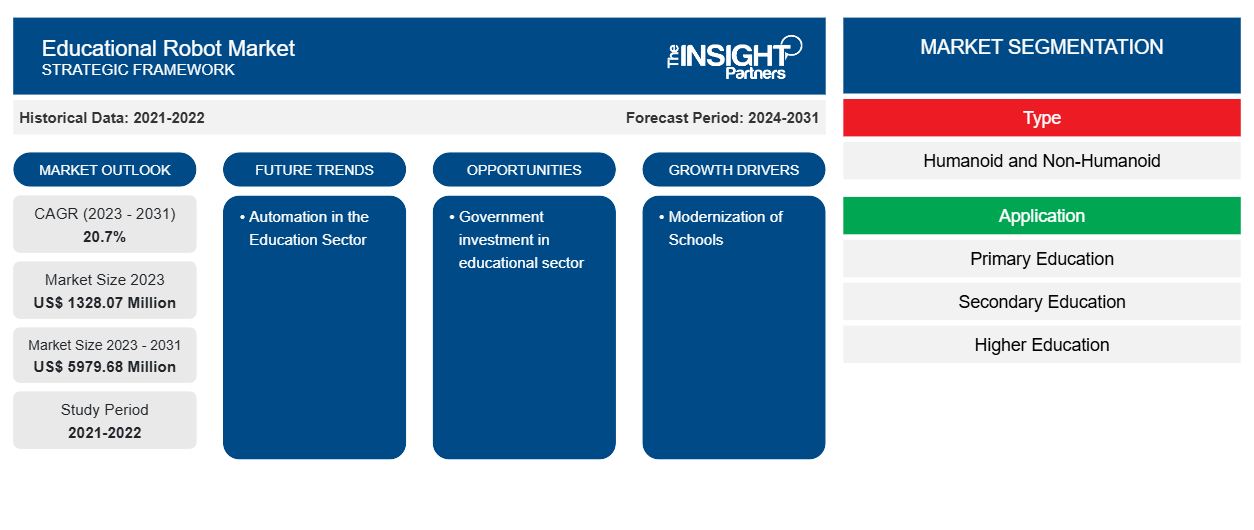Si prevede che il mercato dei robot educativi raggiungerà i 5979,68 milioni di dollari entro il 2031, rispetto ai 1328,07 milioni di dollari del 2023. Si prevede che il mercato registrerà un CAGR del 20,7% nel periodo 2023-2031. È probabile che gli investimenti governativi in robotica e automazione nel settore dell'istruzione rimangano tendenze chiave nel mercato.
Analisi del mercato dei robot educativi
La crescente attenzione al potenziamento di scienza, tecnologia, ingegneria e matematica (STEM) sta guidando la crescita del mercato. Gli investimenti nel sistema educativo da parte delle autorità governative promuovono ulteriormente la crescita del mercato. Scuole e college stanno includendo vari aspetti della robotica che spingono la crescita del mercato.
Panoramica del mercato dei robot educativi
I robot educativi sono robot programmabili che consentono agli studenti di tutte le età di approfondire la loro conoscenza della robotica e della programmazione. Inoltre, li aiutano ad apprendere altre competenze cognitive. Forniscono agli studenti tutto ciò di cui hanno bisogno per costruire e programmare un robot in grado di svolgere una varietà di compiti.
Personalizza questo report in base alle tue esigenze
Riceverai la personalizzazione gratuita di qualsiasi report, comprese parti di questo report, o analisi a livello nazionale, pacchetto dati Excel, oltre a usufruire di grandi offerte e sconti per start-up e università
-
Scopri le principali tendenze di mercato in questo rapporto.Questo campione GRATUITO includerà analisi di dati che spaziano dalle tendenze di mercato alle stime e alle previsioni.
Driver e opportunità del mercato dei robot educativi
Modernizzazione delle scuole
Il governo sta investendo molto nel settore dell'istruzione per modernizzare scuole e college e migliorare ulteriormente l'apprendimento degli studenti. Questi investimenti stanno incoraggiando gli operatori del mercato a fornire i loro robot educativi nelle scuole, il che sta guidando la crescita del mercato. Ad esempio, nell'aprile 2022, la danese Shape Robotics ha affermato di aver firmato un accordo con la pari locale KUBO Robots per distribuire robot educativi alle scuole in Romania.
Automazione nel settore dell'istruzione
Il sondaggio globale del 2023 di ABB su 2.301 professionisti dell'istruzione ha scoperto che l'80 percento ritiene che robot e automazione plasmeranno il futuro dell'occupazione nei prossimi dieci anni. L'uso di robot nel sistema educativo e nei programmi di insegnamento. Gli attori del mercato dei robot industriali si concentrano sul lancio di robot nel settore dell'istruzione che possono alimentare il mercato dei robot educativi in futuro.
Analisi della segmentazione del rapporto di mercato dei robot educativi
I segmenti chiave che hanno contribuito alla derivazione dell'analisi di mercato dei robot educativi sono tipologia e applicazione.
- In base al tipo, il mercato dei robot educativi è segmentato in umanoidi e non umanoidi. Il segmento non umanoide ha detenuto la quota maggiore del mercato nel 2023.
- Per applicazione, il mercato è segmentato in istruzione primaria, istruzione secondaria, istruzione superiore e altri. L'altro segmento deteneva una quota significativa del mercato nel 2023.
Analisi della quota di mercato dei robot educativi per area geografica
L'ambito geografico del rapporto sul mercato dei robot educativi è suddiviso principalmente in cinque regioni: Nord America, Asia Pacifico, Europa, Medio Oriente e Africa, Sud e Centro America.
Si prevede che la regione Asia-Pacifico crescerà con il CAGR più elevato durante il periodo di previsione. La regione è focalizzata sul progresso tecnologico nel settore educativo. L'investimento crescente nel settore educativo integra la crescita del mercato. L'introduzione di robot nelle scuole guida ulteriormente la crescita del mercato nella regione. Ad esempio, a marzo 2024, una scuola del Kerala ha introdotto la prima insegnante di intelligenza artificiale del paese, Iris, per compiere un passo innovativo verso l'istruzione. Iris è stata creata in collaborazione con Makerlabs Edutech ed è la prima insegnante robot umanoide dello stato e probabilmente della nazione. Iris è in grado di rispondere a domande complesse su vari argomenti, offrendo supporto vocale personalizzato e promuovendo opportunità educative interattive. Inoltre, Iris è dotata di ruote per aumentare la mobilità.CAGR during the forecast period. The region is focused on technological advancement in the educational sector. The rising investment in the educational sector Kerala school introduced the country’s first AI Teacher, Iris to take an innovative step towards education. Iris was created in partnership with Makerlabs Edutech and is the state's and probably the nation's first humanoid robot teacher. Iris is capable of answering intricate queries across various subjects, offering individualized voice support, and promoting interactive educational opportunities. In addition, Iris is equipped with wheels to increase mobility.
Approfondimenti regionali sul mercato dei robot educativi
Le tendenze regionali e i fattori che influenzano il mercato dei robot educativi durante il periodo di previsione sono stati ampiamente spiegati dagli analisti di Insight Partners. Questa sezione discute anche i segmenti e la geografia del mercato dei robot educativi in Nord America, Europa, Asia Pacifico, Medio Oriente e Africa e America meridionale e centrale.

- Ottieni i dati specifici regionali per il mercato dei robot educativi
Ambito del rapporto sul mercato dei robot educativi
| Attributo del report | Dettagli |
|---|---|
| Dimensioni del mercato nel 2023 | 1328,07 milioni di dollari USA |
| Dimensioni del mercato entro il 2031 | 5979,68 milioni di dollari USA |
| CAGR globale (2023-2031) | 20,7% |
| Dati storici | 2021-2022 |
| Periodo di previsione | 2024-2031 |
| Segmenti coperti |
Per tipo
|
| Regioni e Paesi coperti |
America del Nord
|
| Leader di mercato e profili aziendali chiave |
|
Densità dei giocatori del mercato dei robot educativi: comprendere il suo impatto sulle dinamiche aziendali
Il mercato dei robot educativi sta crescendo rapidamente, spinto dalla crescente domanda degli utenti finali dovuta a fattori quali l'evoluzione delle preferenze dei consumatori, i progressi tecnologici e una maggiore consapevolezza dei vantaggi del prodotto. Con l'aumento della domanda, le aziende stanno ampliando le loro offerte, innovando per soddisfare le esigenze dei consumatori e capitalizzando sulle tendenze emergenti, il che alimenta ulteriormente la crescita del mercato.
La densità degli operatori di mercato si riferisce alla distribuzione di aziende o società che operano in un particolare mercato o settore. Indica quanti concorrenti (operatori di mercato) sono presenti in un dato spazio di mercato in relazione alle sue dimensioni o al valore di mercato totale.
Le principali aziende che operano nel mercato dei robot educativi sono:
- Robotica Aisoy
- Azienda: Hanson Robotics Limited
- Robotica modulare
- Robotica PAL
- Società americana FANUC
- Tecnologia di innovazione Sanbot Ltd
Disclaimer : le aziende elencate sopra non sono classificate secondo un ordine particolare.

- Ottieni una panoramica dei principali attori del mercato dei robot educativi
Notizie e sviluppi recenti sul mercato dei robot educativi
Il mercato dei robot educativi viene valutato raccogliendo dati qualitativi e quantitativi dopo la ricerca primaria e secondaria, che include importanti pubblicazioni aziendali, dati associativi e database. Di seguito sono elencati alcuni degli sviluppi nel mercato dei robot educativi:
- ABB Robotics ha ampliato la sua offerta formativa con il lancio dell'IRB 1090. Il robot didattico industriale 1090, autenticato dall'istituto di istruzione riconosciuto a livello mondiale STEM.org, è progettato per migliorare le competenze degli studenti e fornire loro un vantaggio competitivo nell'ottenere un impiego. Il nuovo robot didattico costituisce una parte fondamentale dell'offerta formativa più ampia di ABB, che include robot industriali aggiuntivi, nonché pacchetti di istruzione, controller di nuova generazione e software di programmazione e simulazione leader di mercato. (Fonte: ABB Robotics, comunicato stampa, settembre 2023)
- MatataStudio, un fornitore di soluzioni di apprendimento digitale con innovazione e originalità al centro, ha lanciato un nuovo kit di robot educativo chiamato "VinciBot", che mira a combinare informatica, intelligenza artificiale e istruzione in modo divertente. Concetti high-tech come (AI) e apprendimento automatico (ML) vengono introdotti nelle aule delle scuole primarie. Questi kit di robotica non sono solo altamente educativi, ma incorporano anche programmazione, pensiero computazionale, creatività ed esplorazione. Il concetto di design di MatataStudio è quello di incoraggiare i bambini a padroneggiare le conoscenze di base di programmazione e informatica costruendo e azionando robot con le proprie mani, coltivando al contempo il loro pensiero innovativo e le capacità di risoluzione dei problemi. (Fonte: MatataStudio, comunicato stampa, febbraio 2024)
Copertura e risultati del rapporto sul mercato dei robot educativi
Il rapporto "Dimensioni e previsioni del mercato dei robot educativi (2021-2031)" fornisce un'analisi dettagliata del mercato che copre le seguenti aree:
- Dimensioni e previsioni del mercato dei robot educativi a livello globale, regionale e nazionale per tutti i segmenti di mercato chiave coperti dall'ambito
- Tendenze del mercato dei robot educativi, nonché dinamiche di mercato come driver, vincoli e opportunità chiave
- Analisi dettagliata delle cinque forze PEST/Porter e SWOT
- Analisi di mercato dei robot educativi che copre le principali tendenze del mercato, il quadro globale e regionale, i principali attori, le normative e i recenti sviluppi del mercato
- Analisi del panorama industriale e della concorrenza che copre la concentrazione del mercato, l'analisi della mappa di calore, i principali attori e gli sviluppi recenti nel mercato dei robot educativi
- Profili aziendali dettagliati
- Analisi storica (2 anni), anno base, previsione (7 anni) con CAGR
- Analisi PEST e SWOT
- Valore/volume delle dimensioni del mercato - Globale, Regionale, Nazionale
- Industria e panorama competitivo
- Set di dati Excel
Report recenti
Rapporti correlati
Testimonianze
Motivo dell'acquisto
- Processo decisionale informato
- Comprensione delle dinamiche di mercato
- Analisi competitiva
- Analisi dei clienti
- Previsioni di mercato
- Mitigazione del rischio
- Pianificazione strategica
- Giustificazione degli investimenti
- Identificazione dei mercati emergenti
- Miglioramento delle strategie di marketing
- Aumento dell'efficienza operativa
- Allineamento alle tendenze normative























 Ottieni un campione gratuito per - Mercato dei robot educativi
Ottieni un campione gratuito per - Mercato dei robot educativi